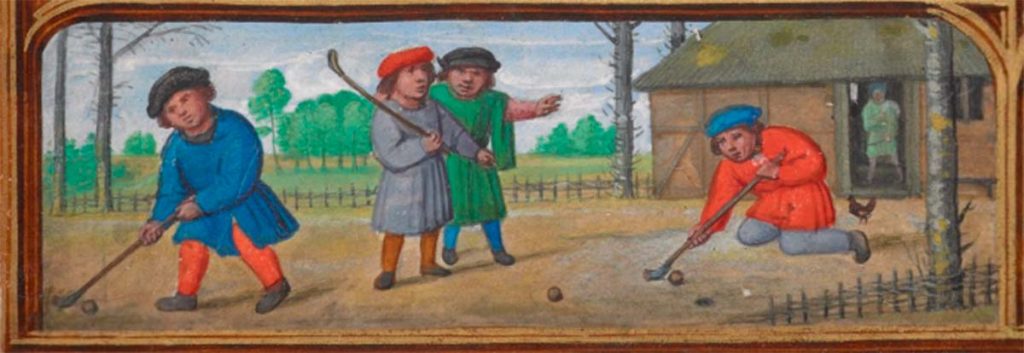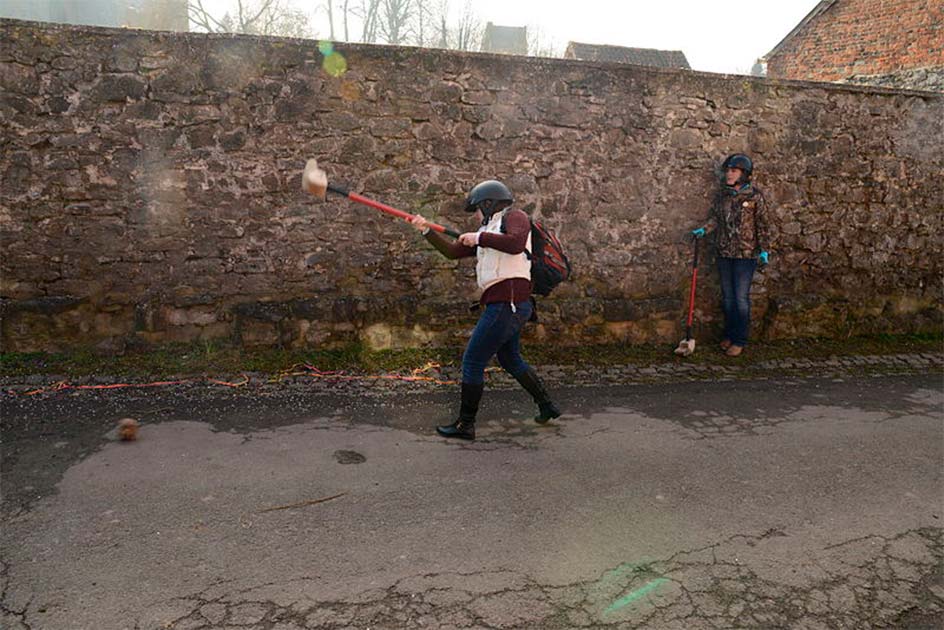Is there a popular sport more polarizing than golf? People either seem to love it or hate it. To some, it’s the ultimate display of precision and skill as golfers send tiny little balls soaring hundreds of yards through the sky toward a tiny little hole in the ground. To others, it’s a tedious game of people hitting balls with expensive sticks.
Whatever your opinion on the sport, its history is as rich and intricate as the fairways it’s played on. But it is a confusing history as well, and there are two very different schools of thought as to where the sport originated.
Depending on who you listen to, golf either started almost 800 years ago in the Netherlands or is a much more modern invention hailing from Scotland. The truth, as is so often the case with history, lies somewhere in between.
Who Invented Golf?
Much like with other popular sports, who (or which country) first developed golf is up for debate. While the modern game of golf is widely considered to be a Scottish invention, the Dutch have also laid claim to it, as well as several other European nations.
The problem is, how do you define golf? People have been hitting round objects with sticks for an exceedingly long time.
We have records going back as far as 1261 AD of people in the Netherlands playing a game where they hit balls into holes with sticks. In the Flemish poet Jacob van Maerlant’s Boeck Merlijn he describes the Dutch game of “mit ener coluen” which involved using a “colf” or “kolf” club to hit balls.

Over the centuries the word colf or kolf was repeatedly mentioned. In 1360 the council of Brussels banned the game, in 1389 the city of Haarlem was gifted its own colf field (a first) by its regent, and a European book of hours prayer book from 1540 makes mention of the game.
We also know that the Dutch game even made its way across to the New World. In December 1650, the Dutch settlers of Fort Orange (Albany, New York today) played kolf for the first time on American soil. It was so popular, played year-round, that in 1659 the colony’s ruler had to pass an ordinance banning people from playing it in the settlement’s streets.
It seems pretty clear then that kolf acted as a precursor to golf and has been around for centuries. Which begs the question- how have the Scots managed to lay claim to it? Let’s explain.
Some claim that golf arose when Scottish shepherds, seeking a way to pass the time, began hitting stones into rabbit holes using crude sticks. Over time, these rudimentary activities evolved into a more organized game. As The Royal and Ancient Golf Club of St. Andrews puts it: “Stick and ball games have been around for many centuries, but golf as we know it today, played over 18 holes, clearly originated in Scotland.”
While pinpointing a single inventor is impossible, a significant milestone in golf’s history is attributed to King James II of Scotland. In 1457, he issued a royal decree banning golf and football, as they were seen as distractions from archery practice. This decree inadvertently contributed to the sport’s popularity and golf enthusiasts persisted in playing it clandestinely.
In fact, golf was repeatedly banned. In 1471 and 1491 acts were brought in banning it for being “unprofitable”, it was then banned again by King James IV of Scotland although he seems to have changed his mind after being repeatedly gifted sets of clubs and balls while visiting Perth, St Andrews, and Edinburgh. Mary, Queen of Scots is said to have been a big fan of the game. She was criticized for playing golf following the murder of her husband, Lord Darnley, in 1567.
It seems most likely that the earliest inspiration for the sport does come from the Dutch word “kolf” or “kolve.” However, it was in Scotland that the game as we know it today evolved from simply hitting balls with sticks to something a little more sophisticated. In essence, golf’s invention was a collaborative effort.
Early Golf Rules
Golf has changed a lot over the years, in its infancy the sport was a far cry from the manicured courses and meticulously designed clubs we know today. The early versions of the game were played on rugged, natural terrain, and the equipment was rudimentary at best.
Early golfers used wooden sticks or mallets, often referred to as “feathery clubs” to hit leather balls that had been stuffed with feathers. These early clubs lacked the precision and variety of modern golf clubs, making each swing somewhat of a “Hail Mary”.

The course was pretty much non-existent. Golfers played across vast landscapes, tackling uneven ground, and navigating natural obstacles. The objective was simple: hit the ball as close to the target as possible in the fewest strokes. In the early days it was common for people to play the game in the streets and in colder climates it was even played on ice.
It was also an incredibly social sport. People tended to play in small groups and the camaraderie and conversations among players were as integral to the experience as the game itself. The game was all about having fun (which is one of the reasons it was repeatedly banned). This laid-back nature meant rules were informal and varied from place to place.
- The Fall of Jai Alai, America’s Forgotten Sport (Video)
- Reviving a 3,000-year-old Ancient Mesoamerican Ballgame (Video)
As golf became more popular people felt the need to remove some of the chaos (and perhaps some of the fun) by trying to standardize the rules. The first international golf contest is said to have occurred in 1681 when James VII of Scotland (still Duke of Albany back then) played against two English courtiers. They played over the rights to claim the game for either England or Scotland.
The first signs of standardization can be found in the writings of Thomas Kincaid, a medical student from Edinburgh University. In his diary from 1687, he wrote about an early handicap system, noted the rules he played by, and described his golf stroke.
The oldest surviving “official rules” come from 1744 and were written by the Company of Gentlemen Golfers, now known as The Honourable Company of Edinburgh Golfers, who played in the same part of Edinburgh as Thomas Kincaid once had. In a document known as the Leith Rules, now held at the National Library of Scotland, they laid down many of the rules that formed the basis for later golf rules books. It was they who noted rules such as “Your Tee must be upon the ground” and “You are not to change the Ball which you strike off the Tee”.
The 19th century saw the expansion of golf beyond Scotland’s borders, with courses popping up in England and other countries. This period also witnessed innovations in equipment, including the transition from feathery balls to the more durable gutta-percha balls, and the development of iron-headed clubs.

However, perhaps the most transformative moment in golf’s history occurred in the 20th century with the advent of television. The broadcast of major tournaments, such as The Masters and The Open Championship, brought the sport to a global audience and fueled its popularity. Golfers like Arnold Palmer, Jack Nicklaus, and Tiger Woods became household names, further elevating the sport’s status.
Technological advancements have also played a pivotal role in golf’s evolution. Modern golf clubs are crafted using cutting-edge materials and engineering techniques, while courses are meticulously designed to challenge even the most skilled players.
A Global Game
What began as a simple game played by common folk (and the occasional Royal) has grown into a global phenomenon, captivating players, and spectators alike. The sport has also become big business. In 2022 the PGA’s peak revenue was $110 million, with the average PGA golfer making $1.5 million.
But this isn’t all good news. Unlike many other sports, golf has a pricey barrier to entry, golfing equipment doesn’t come cheap, nor does membership of a golf club. There are also concerns that developments in technology can give the wealthiest players an unfair advantage.
The enduring appeal of golf lies in its ability to bridge generations and cultures, fostering camaraderie and competition. It’s a sport that defies tradition while honoring its roots, proving that even the most ancient of pastimes can surprise us with their modern twists. As the sport continues to evolve and rise in popularity, we should remember what made it so popular in the first place.
Top Image: 13th century depiction of what may be “kolf”, which would make it the earliest known depiction of golf. Source: Stad Brugge / CC BY-SA 4.0.